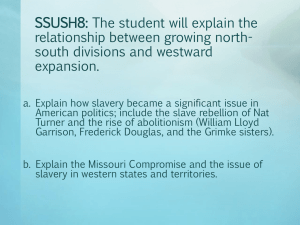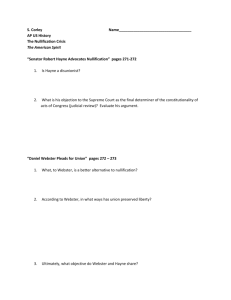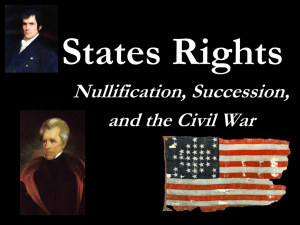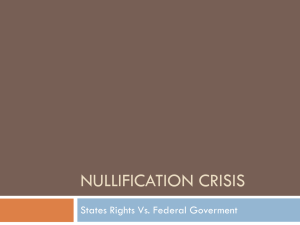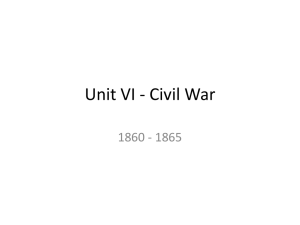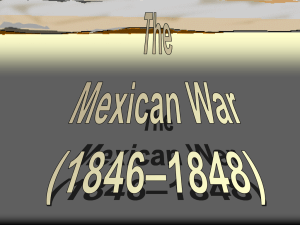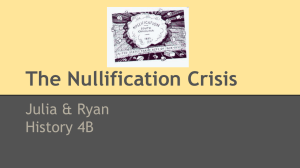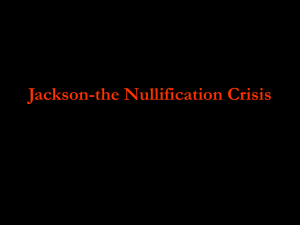Nullification - Worth County Schools
advertisement
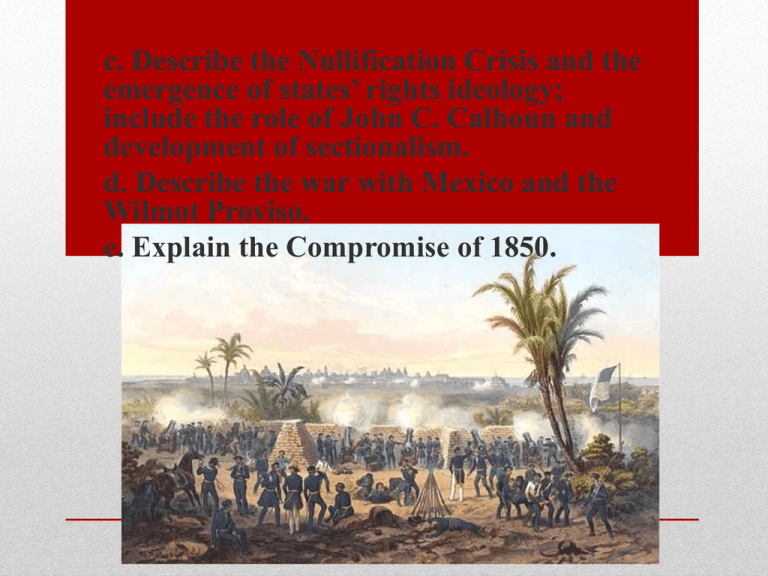
c. Describe the Nullification Crisis and the emergence of states’ rights ideology; include the role of John C. Calhoun and development of sectionalism. d. Describe the war with Mexico and the Wilmot Proviso. e. Explain the Compromise of 1850. Nullification Crisis • In the early 1800s South Carolina’s economy began to weaken in part due to high government tariffs, or taxes, on imports. • In 1828 Congress passed another tariff, which many called the Tariff of Abominations. • South Carolina threatened to secede over the high tariffs. Why would tariffs hurt Southern states like South Carolina more than Northern States? Nullification Crisis • Vice-President John C. Calhoun, from South Carolina, supported the idea of nullification, or the right of the states to declare federal laws null, or void. • He declared that states had this power of nullification because the states had created the federal government. Nullification Crisis • In 1832, Congress passed yet another tariff. • In November 1832, South Carolina declared the tariffs null, and refused to pay the federal government’s taxes on imports. Nullification Crisis • President Andrew Jackson ordered a warship to Charleston, viewing the nullification as a treasonous act. • To ease tensions, Congress passed a bill that gradually lowered tariffs. • South Carolina repealed its nullification of tariffs and the issue was temporarily solved. How was the Nullification Crisis an example of sectionalism? War With Mexico • James Polk became President in 1845, promising to annex Texas and Oregon. • The U.S. annexes Texas, causing a boundary dispute with Mexico. • Polk ordered the army into the disputed area -Mexican troops open fire on the Americans • Polk then declared war on Mexico, claiming they were the aggressor • The American army is ordered into Mexico, and out to California. • Before the troops can reach California, a group of American settlers revolt and take the area naming it the Bear Flag Republic. • In 1847, the U.S. Army enters Mexico City causing the Mexicans to surrender ending the war. War With Mexico War With Mexico • Treaty of Guadalupe Hidalgo ended the war, giving the U.S. a vast amount of land in the Southwest. • The U.S. now stretched from the Atlantic to the Pacific Ocean. Why would this treaty cause problems with the Slavery issue? Wilmot Proviso • Proposed in 1846, that any territory gained from Mexico would not be allowed to have slaves. • The proposal upset Southerners, and though it passed in the House, the Senate refused to vote on it. • The Wilmot Proviso continued a north-south sectionalism over the slavery issue. Wilmot Proviso • To counter the Wilmot Proviso and to ease tension, a proposal was made to allow the new territories to decide for themselves on the slavery issue, an idea called popular sovereignty. • California applied for statehood in 1849, threatening to break the balance of free and slave states. • Henry Clay proposed a resolution which became know as the Compromise of 1850. Compromise of 1850 Though the Compromise initially had little support, it was passed, by dividing it into smaller bills, allowing Congress to vote on each issue separately easing the tension over slavery. Questions 1. How was the Nullification Crisis an example of sectionalism? 2. What caused the US to go to war with Mexico? What did the US gain from winning the war? 3. How was the Wilmot Proviso connected to the Mexican War? 4. Why was the Compromise of 1850 necessary?
